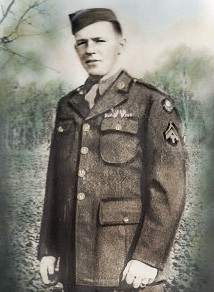On 25 June 1924, William F Finley was born in Macon, Macon County, Illinois, USA. He enlisted and served in the 39th Infantry Regiment, 9th Infantry Division.
The Division was one of the first US combat units to see action in the Pacific theatre of war. They would then be redeployed to Africa in 1942 and Italy in 1943. They would be withdrawn from Italy and sent to the UK for training prior to D-Day, 6 June 1944. They would land on Utah Beach on D+4, 10 June. They would immediately push northwards and towards the city of Cherbourg.
Initially, the 39th Infantry Regiment was attached to the US 4th Infantry Division as they pushed along the eastern coastline of the Cotentin. The regiment was known as the ‘Anything, Anywhere, Anytime- Bar Nothing!’ Following the capture of Quineville, the Regiment returned to the Division. Between 14 and 25 June, the Division fought against stubbornly well-placed German defences. They slowly surrounded the city as the Germans started to use the port's defences, but slowly the Americans neutralised this threat. The port had been scuttled and badly damaged beyond use. The German forces surrendered the following day.
It was here at the Hotel de Ville that Sergeant William F. Finley became the first US soldier to arrive. This is commemorated with a plaque to him.
He went on to follow the American advance into Germany. During his active service, he was awarded a Bronze Star with two Oak Leaf Clusters and a Purple Heart. He died of wounds on 1 April 1945 and is buried at the Netherlands American Cemetery, Margraten. His final gallantry award, a silver star, was awarded posthumously.
‘The President of the United States of America, authorized by Act of Congress July 9, 1918, takes pride in presenting the Silver Star (Posthumously) to Sergeant William F. Finley (ASN: 35782572), United States Army, for gallantry in action while serving with the 9th Infantry Division, in action against the enemy on 12 December 1944, in the vicinity of Derichweiler, Germany. While accompanying his company commander on a reconnaissance mission, Sergeant Finley was subjected to intense enemy machine pistol fire. Working his way around to the front of the house, he then crawled across the roof of a barn, although he was exposed to the direct observation and fire of the enemy located in the shed of the barn. Opening fire on the shed with his rifle, he then jumped from the rooftop and raced to the window of the shed. He threw two hand grenades inside the building and killed two enemy soldiers, neutralizing a mortar observation post. His gallant actions and dedicated devotion to duty, without regard for his own life, were in keeping with the highest traditions of military service and reflect great credit upon himself, his unit, and the United States Army.’
